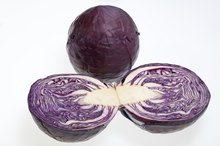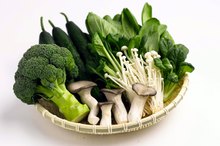What does fact checked mean?
At Healthfully, we strive to deliver objective content that is accurate and up-to-date. Our team periodically reviews articles in order to ensure content quality. The sources cited below consist of evidence from peer-reviewed journals, prominent medical organizations, academic associations, and government data.
The information contained on this site is for informational purposes only, and should not be used as a substitute for the advice of a professional health care provider. Please check with the appropriate physician regarding health questions and concerns. Although we strive to deliver accurate and up-to-date information, no guarantee to that effect is made.
What Are the 6 Food Groups in the Food Pyramid?
The United States Department of Agriculture publishes the most familiar, healthy-eating visual guide, known as the "food pyramid" or "my pyramid." Based on the premise that eating a variety of foods provides all the nutrients necessary for the body's requirements, the food pyramid design uses colored triangles to represent the six food groups 123. These triangles vary in width, depending upon the number of daily servings recommended by the USDA. Although other food pyramids, such as Harvard's School of Public Health's "Healthy Eating Pyramid" exist, the USDA's pyramid remains the most widely used and recognized 23.
Grains, the Orange Triangle
The widest of the triangles, the grain group contains whole and processed grains. The USDA affirms that whole grains provide higher nutrient densities than processed grains. Recommended daily servings depend on age and gender with lower amounts at a 3-ounce limit to higher amounts of an 8-ounce limit, according to the My Pyramid website.
Vegetables, the Green Triangle
List of Antioxidant Vitamins
Learn More
The vegetable group contains five subgroups. One subgroup, the starchy vegetables convert, in part, to sugar once metabolized by the body. The USDA recommends that you consume more dark greens for the calcium content, orange vegetables for their beta-carotene and dry beans and peas for the high-fiber content, rather than relying too heavily on the starchy vegetables. One hundred percent vegetable juice also counts as a serving of vegetables. Adults should consume at least three servings of vegetables daily.
- The vegetable group contains five subgroups.
- The USDA recommends that you consume more dark greens for the calcium content, orange vegetables for their beta-carotene and dry beans and peas for the high-fiber content, rather than relying too heavily on the starchy vegetables.
Fruits, the Red Triangle
The fiber provided by the fruit group helps keep blood cholesterol levels in check, which also reduces the risk of developing heart disease, according to the USDA. Fruits contain high amounts of potassium, vitamin C and folic acid as well. Given their easy portability, fresh fruits make nutritious in-between meal snacks, the pyramid suggests. One to 2 cups per day of fruit fills your daily needs.
- The fiber provided by the fruit group helps keep blood cholesterol levels in check, which also reduces the risk of developing heart disease, according to the USDA.
- Given their easy portability, fresh fruits make nutritious in-between meal snacks, the pyramid suggests.
Oils, the Yellow Triangle
Balanced Diet Food List
Learn More
Oil, the smallest of all the food pyramid triangles, contains essential fatty acids vital to cellular functioning 3. The monounsaturated and polyunsaturated fats in foods such as fish, nuts and some vegetables, support the health of your organs. The USDA counts 1 teaspoon of oil as a serving, and adults need between 5 and 7 teaspoons per day.
Milk, the Blue Triangle
The milk group contains a wide variety of food choices. These multiple choices keeps you from relying solely on milk to get your recommended daily servings. Cheese, yogurt, pudding and lactose-free products all fall under the milk group. Choose 3 cups of low-fat or fat-free selections daily to receive your recommended levels of calcium.
- The milk group contains a wide variety of food choices.
- Choose 3 cups of low-fat or fat-free selections daily to receive your recommended levels of calcium.
Meat & Beans, the Purple Triangle
The last food group contains your daily protein needs. The USDA recommends eating fish, beans, seeds and nuts in addition to lean cuts of meats and poultry. Black-eyed peas and chickpeas also fall under the meat and beans group. Adults need between 5 and 6 ounces daily.
- The last food group contains your daily protein needs.
- The USDA recommends eating fish, beans, seeds and nuts in addition to lean cuts of meats and poultry.
Related Articles
References
- Harvard School of Public Health: Healthy Eating Pyramid
- Kids Health: The Food Guide Pyramid
- Mangine GT, Hoffman JR, Gonzalez AM, et al. The effect of training volume and intensity on improvements in muscular strength and size in resistance-trained men. Physiol Rep. 2015;3(8). doi:10.14814/phy2.12472
- International Sports Sciences Association. Is your warm up routine sabotaging your training?.
- American Council on Exercise. Five reasons you shouldn’t skip your cool-down after exercise. January 2014.
- American Council on Exercise. Weight lifting tempo; sets: how to select the right sets for your clients. July 2014.
Writer Bio
Gloria Attar is a registered nurse specializing in cardiac critical care. She has been a professional writer since 1983, covering health care, wellness and nutrition topics. Attar earned her Bachelor of Science in nursing from Kent State University.









